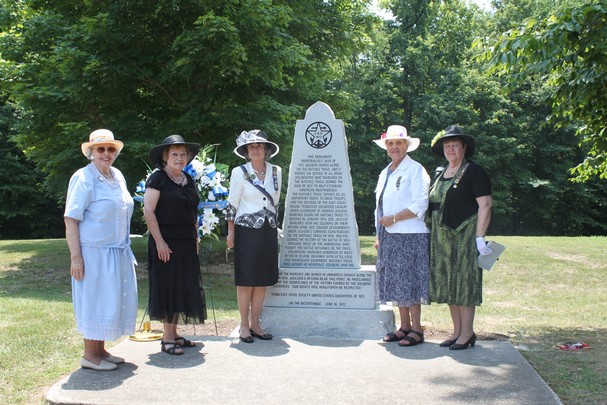
|
Photos provided by Aline Gray Roberts Hon. VP National and Hon. TN State President
Bicentennial marker placed by Daughters of 1812Posted: Friday, June 29, 2012 12:01 am s. Spears. Jim Drury dressed in 1812 uniform, played “Amazing Grace” on bagpipes. Published in The WCP 6.28.12 From Knox News.com Daughters of 1812 participate in parkway dedication
The Natchez Trace, also known as the "Old Natchez Trace", is a historic forest trail within the United States which extends roughly 440 miles (710 km) from Nashville, Tennessee, to Natchez, Mississippi, linking the Cumberland, Tennessee, and Mississippi rivers. The trail was created and used by Native Americans for centuries, and was later used by early European and American explorers, traders, and emigrants in the late 18th and early 19th centuries. European Americans founded inns, also known as "stands", along the Trace to serve food and lodging to travelers. As travel shifted to steamboats on the Mississippi and other rivers, most of these stands closed. Today, the path is commemorated by the 444-mile (715 km) Natchez Trace Parkway, which follows the approximate path of the Trace,[1] as well as the related Natchez Trace Trail. Parts of the original trail are still accessible, and some segments are listed on the National Register of Historic Places. INSCRIPTION ON MONUMENT PLACED BY TENNESSEE SOCIETY This monument memorializes War of 1812 Soldiers buried along the Old Natchez Trace and it honors the service of all brave volunteers who marched on the Natchez Trace during the War of 1812 to help establish American Independence. The Natchez Trace served as an important route to move troops for the defense of the Gulf Coast Region. Tennessee Volunteer Cavalry under the leaderhip of Andrew Jackson marched down the Natchez Trace to Natchez in January 1813. General Jackson marched with 185 soldiers on the their return April 1813. Soldier detachments under Jackson's command again marched on the Natchez Trace in 1814 and following the victory at the Battle of New Orleans, most of the Americans who fought the Battle of New Orleans returned on the Trace. Volunteers marched hundreds of miles, often in severe weather with little food and inadequate equipment. Natchez Trace Inns served as hospitals. Soldiers who did not survive the marches are buried in graves unmarked along the Trace. On General Jackson's return, near this point he proclaimed his view of the significance of the victory earned by the soldiers' sacrifices, 'OUR RIGHTS WILL HENCEFORTH BE RESPECTED."
Tony L. Trumball, President of the Natchez Trace Parkway Association, noted that Tennessee became known as "the Volunteer State" during the War of 1812 when over 2,000 men answered the call for troops. Upon Jackson's return after the Battle of New Orleans towns along the Natchez Trace met returning soldiers with celebrations and illumniations, by placing candles in windows. Jackson returned on the Trace in a carriage accompanied by his wife and son who had come to meet him. Statement:" Our rights will henceforth be respected" is quoted from a victory speech Jackson made to the residents of Franklin, Tennessee when he was urged to speak.
|
|
